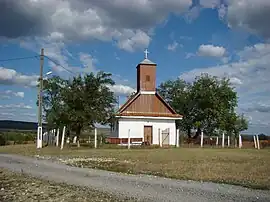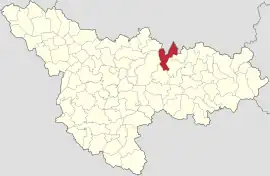Brestovăț | |
|---|---|
 The Serbian wooden church in Lucareț | |
 Location in Timiș County | |
 Brestovăț Location in Romania | |
| Coordinates: 45°52′23″N 21°40′52″E / 45.87306°N 21.68111°E | |
| Country | Romania |
| County | Timiș |
| Established | 1440 (first attested) |
| Subdivisions | Brestovăț, Coșarii, Hodoș, Lucareț, Teș |
| Government | |
| • Mayor (2020–2024) | Eugen Dobra[1] (PNL) |
| Area | 103.17 km2 (39.83 sq mi) |
| Population (2021-12-01)[3] | 675 |
| • Density | 6.5/km2 (17/sq mi) |
| Time zone | EET/EEST (UTC+2/+3) |
| Postal code | 307085–307089 |
| Vehicle reg. | TM |
| Website | www |
Brestovăț (Hungarian: Aga, until 1892 Bresztovác; German: Brestowatz; Slovak: Brestovec) is a commune in Timiș County. It is composed of five villages: Brestovăț (commune seat), Coșarii, Hodoș, Lucareț and Teș.
History
Brestovăț first appears in written history as Breztolcz in 1440; at that time, it belonged to the Șoimoș Fortress.[4] It was destroyed during the Turkish occupation and resettled in 1718–1722.[4] Turks called it Aga, an unofficial name that persisted for a while and was taken over by Hungarians and later by the Romanian administration.
Between 1735 and 1737, 113 families of Montenegrin Serbs, mostly Orthodox, settled here.[5] In 1797, Brestovăț became the property of the Lukács brothers, who colonized a large number of Hungarian and Slovak settlers here.[5] Around 1828, now a property of Iosif Gaal, it was again colonized by Hungarians from Nógrád, Nyitra and Trencsén.[5] The colonizations do not stop here, because in 1840–1845, German settlers from Bohemia arrived in Brestovăț.
Demographics
Brestovăț had a population of 674 inhabitants at the 2011 census, down 18% from the 2002 census. Most inhabitants are Romanians (76.26%), larger minorities being represented by Slovaks (15.13%), Serbs (1.63%), Hungarians (1.48%) and Roma (1.19%). For 3.71% of the population, ethnicity is unknown.[6] By religion, most inhabitants are Orthodox (74.78%), but there are also minorities of Roman Catholics (17.66%) and Baptists (2.82%). For 3.71% of the population, religious affiliation is unknown.[7]
| Census[8] | Ethnic composition | ||||||
|---|---|---|---|---|---|---|---|
| Year | Population | Romanians | Hungarians | Germans | Roma | Serbs | Slovaks |
| 1880 | 3,725 | 2,601 | 224 | 208 | – | 280 | 407 |
| 1890 | 3,934 | 2,684 | 259 | 235 | – | 298 | 442 |
| 1900 | 4,417 | 3,000 | 447 | 256 | – | 226 | 444 |
| 1910 | 4,471 | 2,933 | 517 | 151 | – | 367 | 425 |
| 1920 | 3,895 | 2,583 | 285 | 117 | – | – | – |
| 1930 | 3,853 | 2,764 | 216 | 188 | 105 | 107 | 455 |
| 1941 | 3,709 | 2,742 | 192 | 262 | – | – | – |
| 1956 | 3,210 | 2,481 | 144 | 73 | – | 112 | 397 |
| 1966 | 2,328 | 1,728 | 58 | 59 | 16 | 83 | 378 |
| 1977 | 1,364 | 873 | 42 | 44 | 9 | 52 | 338 |
| 1992 | 851 | 596 | 10 | 27 | – | 33 | 185 |
| 2002 | 818 | 589 | 19 | 16 | – | 43 | 151 |
| 2011 | 674 | 514 | 10 | 3 | 8 | 11 | 102 |
References
- ↑ "Results of the 2020 local elections". Central Electoral Bureau. Retrieved 16 June 2021.
- ↑ "Primăria Brestovăț". Ghidul Primăriilor.
- ↑ "Populaţia rezidentă după grupa de vârstă, pe județe și municipii, orașe, comune, la 1 decembrie 2021" (XLS). National Institute of Statistics.
- 1 2 Szabó, M. Attila (2003). Erdély, Bánság és Partium történeti és közigazgatási helységnévtára. Miercurea Ciuc: Pro-Print Kiadó.
- 1 2 3 "Istoric". Primăria comunei Brestovăț.
- 1 2 "Tab8. Populația stabilă după etnie – județe, municipii, orașe, comune". Institutul Național de Statistică. Archived from the original on 2016-01-18. Retrieved 2021-09-10.
- 1 2 "Tab13. Populația stabilă după religie – județe, municipii, orașe, comune". Institutul Național de Statistică. Archived from the original on 2020-08-07. Retrieved 2021-09-10.
- ↑ Varga, E. Árpád. "Temes megye településeinek etnikai (anyanyelvi/nemzetiségi) adatai 1880-2002" (PDF). Archived from the original (PDF) on 2007-06-10. Retrieved 2021-09-10.
